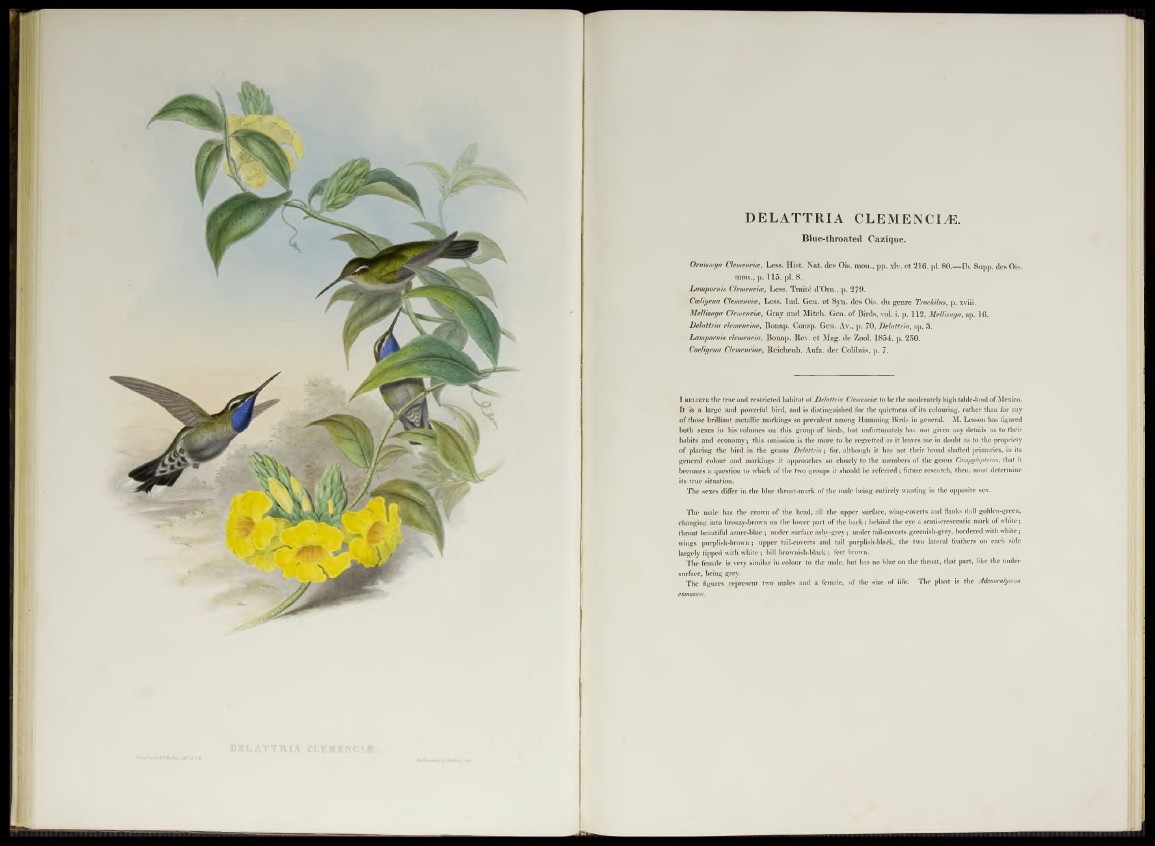
JfoiM m lXC lhc/ iltr, M d hllv
DELATTRIA CLEMENCIJE.
Blue-throated Cazique.
Omismya Clemencite, Less. Hist. Nat. des Ois. mou., pp. xlv. et 216. pl. 80.—Ib. Supp. des Ois.
mou., p. 115. pl. 8.
Lam/pornis Cïemenciee, Less. Traité d’Om., p. 279.
Cceligena Clemencia, Less. Ind. Gen. et Syn. des Ois. du genre Trochilus, p. xviii.
Mellisuga Clemencüe, Gray and Mitch. Gen. of Birds, vol. i. p. 112, Mellisuqa, sp. 16.
Delattria clemenciae, Bonap. Consp. Gen. Av., p. 70, Delattria, sp. 3.
Lampornis clemencia, Bonap. Rev. et Mag. de Zool. 1854, p. 250.
Coeligena Clemenciae, Reichenb. Aufz. der Colibris, p. 7.
I believe the true and restricted habitat of Delattria Clemencice to be the moderately high table-land of Mexico.
It is a large and powerful bird, and is distinguished for the quietness of its colouring, rather than for any
of those brilliant metallic markings so prevalent among Humming Birds in general. M. Lesson has figured
both sexes in his volumes on this group of birds, but unfortunately has not given any details as to their
habits and economy; this omission is the more to he regretted as it leaves me in doubt as to the propriety
of placing the bird in the genus Delattria; for, although it has not their broad shafted primaries, in its
general colour and markings it approaches so closely to the members of the genus Campylopterus, that it
becomes a question to which of the two groups it should be referred; future research, then, must determine
its true situation.
The sexes differ in the blue throat-mark of the male being entirely wanting in the opposite sex.
The male has the crown of the head, all the upper surface, wing-coverts and danks dull golden-green,
changing into bronzy-brown on the lower part of the back; behind the eye a semi-crescentic mark of white;
throat beautiful azure-blue ; under surface ashy-grey; under tail-coverts greenish-grey, bordered with white;
wings purplish-brown ; upper tail-coverts and tail purplish-black, the two lateral feathers on each side
largely tipped with white ; bill brownish-black ; feet hrown.
The female is very similar in colour to the male, but has no blue on the throat, that part, like the under
surface, being grey.
The figures represent two males and a female, of the size of life. The plant is the Adenocalymna
comosum.